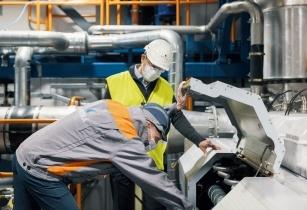Wärtsilä, the technology group, has announced the adoption of hydrogen and ammonia as viable engine fuels through advanced testing in Wärtsilä’s fuel-flexible combustion engines
Hydrogen and ammonia contain no carbon, meaning the combustion releases no CO2 emissions. Full-scale engine tests have been recently carried out in Wärtsilä's engine laboratory in Vaasa, Finland, to assess the optimum engine parameters for running on these fuels. The test results are very encouraging, with one test engine performing very well when running on a fuel with 70% ammonia content at a typical marine load range. Tests were also completed successfully on another engine in pure hydrogen operation.
Testing will continue throughout the coming years with the aim of defining the most feasible internal combustion engine-based solutions for power plant and marine applications, thereby enabling the transition to a decarbonised future with green fuels.
For the energy market, Wärtsilä expects to have an engine and plant concept for pure hydrogen operation ready by 2025. For the marine market, the company expects to have an engine running on an ammonia blend already this year. Wärtsilä anticipates having an engine concept with pure ammonia fuel in 2023. In the energy sector, it is anticipated that green hydrogen will deliver 7% of the global energy demand by 2050.
Håkan Agnevall, CEO of Wärtsilä, said, “These are milestone moments in Wärtsilä’s transition to future fuels. Society will have to invest significant amounts into the infrastructure needed to develop green hydrogen, but those investments require market-ready engines that can run on the fuel once it is readily available. The energy and marine industries are on a decarbonisation journey, and the fuel flexibility of the engines powering these sectors is key to enable the transformation."
Wärtsilä is also developing ammonia storage and supply systems as part of the EU’s ShipFC project. The company has already gained significant experience with ammonia from designing cargo handling systems for liquid petroleum gas carrier vessels, many of which are used to transport ammonia.
Wärtsilä’s fuel agnostic approach enables the company to support the energy and marine sectors on how to shape sustainable, and efficient, future fuel strategies in several cost-optimal steps. For example, hydrogen can be used as a fuel in its existing state or as a raw material for producing a wide range of future fuels, including ammonia and synthetic methane, each of which has different benefits for industrial and mobility applications. Wärtsilä’s gas engines are highly flexible and are capable of rapidly ramping up or down in power. When wind and solar power vary with weather conditions, Wärtsilä engines can support the power system by ramping up power to meet the required load, reaching full capacity in under two minutes





















